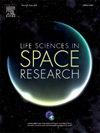在 HIMAC 利用重离子进行空间辐射研究
IF 2.9
3区 生物学
Q2 ASTRONOMY & ASTROPHYSICS
引用次数: 0
摘要
千叶重离子医用加速器(HIMAC)最初主要是为碳离子治疗而设计的,但自 1994 年以来,医学、物理学、化学和生物学方面的重离子研究项目一直是在合作研究框架下进行的。其中一个主要应用是空间辐射研究。人类太空探索最感兴趣的太空辐射包括高能质子和重离子,它们会影响太空乘员的健康并导致电子设备故障。重离子加速器的地面实验对于确保飞行人员的安全和了解长期暴露于空间辐射对生物的影响至关重要。重离子加速中心提供从质子到 Xe 离子的一系列线性能量转移(LET)束,能量高达 800 MeV/u,代表了空间辐射场中对生物影响最大的成分。在 HIMAC,使用特定的单能量重离子束对各种辐射探测器和仪器进行了剂量测定的特征描述和校准,对用于减轻空间辐射剂量的屏蔽材料的性能进行了评估,对电子设备的辐射硬度进行了测试,以确保其在空间的安全运行,并进行了辐射生物学研究,以了解长期空间活动对人体的生物影响。HIMAC 是空间探索新十年不可或缺的空间辐射模拟器。本文章由计算机程序翻译,如有差异,请以英文原文为准。
Space radiation research with heavy ions at HIMAC
The HIMAC (Heavy Ion Medical Accelerator in Chiba) was originally designed principally for carbon ion therapy, but heavy ion research projects in medicine, physics, chemistry and biology have been conducted under a collaborative research framework since 1994. One major application is space radiation research. The radiation in space of greatest interest for human space exploration consists of energetic protons and heavy ions which can affect the health of space crew and lead to the failure of electronic devices. Ground-based experiments at heavy ion accelerators are crucial for ensuring mission crew safety and for understanding the biological effects of long-term exposure to space radiation. HIMAC provides a range of linear energy transfer (LET) beams from protons to Xe ions at energies up to 800 MeV/u, representing the most biologically-significant components of the space radiation field. At HIMAC a variety of radiation detectors and instruments are characterized and calibrated for dosimetry using specific mono-energetic heavy ion beams, the performance of shielding materials for mitigating space radiation dose is evaluated, radiation hardness of electronic devices is tested to ensure their safe operation in space, and the radiobiological studies are conducted to understand biological effects in humans during long-term space activities. HIMAC is an indispensable simulator of space radiation for the new decade of space exploration.
求助全文
通过发布文献求助,成功后即可免费获取论文全文。
去求助
来源期刊

Life Sciences in Space Research
Agricultural and Biological Sciences-Agricultural and Biological Sciences (miscellaneous)
CiteScore
5.30
自引率
8.00%
发文量
69
期刊介绍:
Life Sciences in Space Research publishes high quality original research and review articles in areas previously covered by the Life Sciences section of COSPAR''s other society journal Advances in Space Research.
Life Sciences in Space Research features an editorial team of top scientists in the space radiation field and guarantees a fast turnaround time from submission to editorial decision.
 求助内容:
求助内容: 应助结果提醒方式:
应助结果提醒方式:


